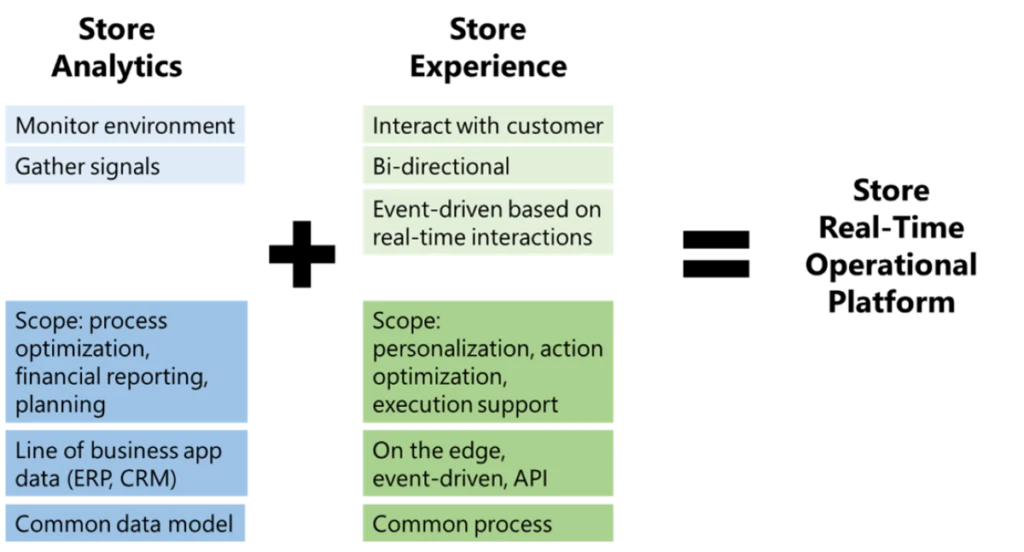
Create your smart store of tomorrow, today
Grandmothers ordering groceries online. Millennials driving through alleyways behind stores to pick up their purchased items rather than walking through stores. Outdoor enthusiasts booking appointments with experts to find the best bike and backpack that fits their needs. Store associates with full visibility about the status of items for sale in any of their stores, and the delivery status of items on their way. These are all examples of how consumers now relate to retailers. Rather than being just a sales channel, stores are now multi-faceted resources, enabling customers to experience products locally while accessing resources of the entire store network.
Certainly, a lot has changed in two years. For example, take a look at this 1500-square-foot store that is unlike any food market most shoppers have ever seen. Retailers have been implementing cloud and edge infrastructure and creating connectivity to enable a modular approach. Stores are truly the new hubs for retail operations. They are points of purchase, fulfillment centers, and experience centers. These shifts are impacting how stores are laid out, what is on their shelves, and what’s expected of employees.
In the store of the future, each store acts independently and swiftly improves and updates the experiences it offers to consumers while providing all the benefits of being a part of a larger retail ecosystem.
Infrastructure view
To make this possible, successful retailers must build a digital foundation for their stores that acts as a modular, flexible framework. This infrastructure framework leverages the same hardware and software assets to deploy multiple use cases in the store. It enables retailers to balance multiple internal initiatives, integrate point solutions, and coordinate technology capabilities such as edge-architecture computing. We find that many if not all retailers prefer adopting a hybrid approach in lighting up store services. Whether it is due to distance from the cloud, networking constraints, cost-saving, or maintenance considerations, many retailers choose to have edge capabilities to allow the store services to produce outcomes at a faster rate. Coupled with the need to interact with on-premises devices such as cameras and the internet of things (IoT) devices, some edge pre-processing skills are also needed.
COVID-19 taught retailers that we don’t know what the future brings. Their north star is to have a modular, solid, and secure platform where they can plug and play as needed. Retailers want a holistic view of a store, where all parts—from endcap to cash register, and out-of-stock detections—play together in real-time, orchestrating data, and putting it to work. And all of this is at the retail associate’s fingertips. Retail customers need a blueprint to lay over their store footprint to define and map Horizon 1 to Horizon 3 scenarios. They need an orchestration platform where all solutions (homegrown and purchased) can be implemented and interact with each other, and most importantly, orchestrate the data and insights across all point solutions.
Imagine if… your store updates itself the way a phone updates its operating system. Your stores change a few features overnight to be personalized to the needs of that particular location, format, and seasonal needs.
Evolve the business strategy
These changes are more than just technology. In this fluid environment, management must reconsider store operational and financial boundaries, so that profit and loss (P&L) and operating cost elements are managed and balanced and take into account each store’s contribution towards online fulfillment, storage, brand building, returns, and marketing.
Whether it’s a fully autonomous store, scan-and-go, smart shelves, smart carts and baskets, curbside pickup, or ultra-fast delivery, technology is a means, not an end, to your store of the future. It is the how not the why. The “why” must align with your business model and your competitive advantage to justify the investment. In our opinion, the fastest way to unlock the value of the store is to have a deliberate data monetization strategy.
Learn more in our recent blog: 5 keys to the frictionless store of tomorrow.
Support the changing role of the store associate
Store associates are part of the transformation as well. They’re expected to nimbly work with new tools and understand the data to support their customers and support the increased efficiency of stores. To do this, stores need to reduce task redundancy and provide education, training, and best-in-class tools to communicate.
Leading retailers invest in empowering, engaging, and continuously re-training the frontline as they automate routine tasks and manual processes. Retail leadership is finding new ways to shift towards employee-centric business models to ensure they are the employer of choice for many while simplifying processes, reducing effort, and increasing productivity. During this time when talent is hard to find and even harder to retain, retailers must find a way to meet the expectations of both employees and customers. Retailers need their workforce to be digital, data-fluent, and diverse.
Reframe. Your customer is the only channel
Once you start to leverage data, the magic begins. You know who each customer is, whether they are online or in the store. You start to personalize, engage with customers smoothly in the store, and consider these use cases that materially support the customer while also providing data to the stores that can increase their hyper-connectivity:
- Automated and frictionless checkout. Microsoft Global ISV partner AiFi has now deployed the largest network of autonomous stores across an array of verticals such as grocery stores, universities, and sports venues.
- Omnichannel customer service.
- Intelligent store returns and recycling.
- Display tech for personalized engagement.
- Mobile tech for personalized engagement.
- Digital shopper engagement.
- Customized manufacturing for in-store personalization.
Digital and physical shopping no longer exists in silos. Instead, shopping has become a completely connected experience.
Become hyper-connected by placing data at the center
Since most of the business value from your store of the future strategy will come from data monetization, your data stack is the foundation for digital transformation. You need to consider how to operationalize data, and how to take data and bring it to the right places. For example, data needs to reach your employees’ hands. There are countless sources of data that can enrich use cases that impact product availability to consumers, including digital shelves, inventory management, and returns. The data has to be effectively everywhere, secured, and managed well everywhere. And it must be put to work. That means data stores need to be available wherever they are needed—whether on-premises or in a cloud provider. This includes a portfolio of relational, non-relational, and other data-relevant technologies for building applications where they are needed.
Hyper-connected retailers realize that we have long passed the point where developer teams can write code that anticipates every situation. There simply isn’t enough developer talent to sustainably develop and maintain an exponentially growing codebase. Instead, hyper-connected retailers develop their data platform strategy to include data models, connectors, data governance, and AI. AI success is predicated on connected and integrated data sets, and AI becomes the new code.

Examples of use cases:
- Digital shelf displays.
- Electronic shelf labels and live personalized pricing.
- Shelf management technology.
- Real-time inventory tracking.
Your smart store—a store where you can change the customer experience overnight—is within your reach. It requires placing employees, customers, and data at the core, to feed a dynamic retail platform that provides insights and analytics that powers our core business processes.
Learn more
Follow Microsoft Retail on Twitter and visit our Microsoft Cloud for Retail website to get the latest on how Microsoft and our partners are helping retailers deliver a seamless experience across the entire shopper journey.




